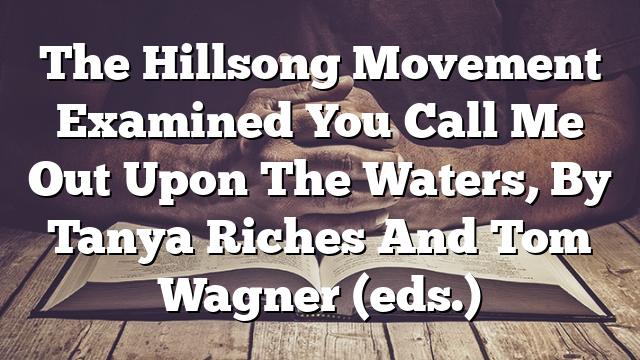Click to join the conversation with over 500,000 Pentecostal believers and scholars
Click to get our FREE MOBILE APP and stay connected
| PentecostalTheology.com



416
Book Reviews
Tanya Riches and Tom Wagner (eds.),The Hillsong Movement Examined: You Call
Me Out Upon the Waters, Christianity and Renewal—Interdisciplinary Studies
(Cham, Switzerland: Palgrave Macmillan, 2017). xxiv + 279 pp. $99.99 hardcover.
The Hillsong Movement Examined: You Call Me Out Upon the Waters is a strong introductory volume giving room for critical understanding of a church move- ment that, “scholars from the around the world have sought to study” (272). Riches and Wagner curate a diverse assortment of scholars from several dis- ciplines who explore the layers of life in the Hillsong global church: history, music, marketing, ecumenical relationships, ethics, etc.The Hillsong Movement Examined is a work that pursues justice for the realm of theological studies by giving voice to scholars primarily from Oceania, both men and women of diverse ethnic origin. The blend of Hillsong insider/outsider perspectives cre- ates an inherent dialogue that invites the reader to engage.
Riches and Wagner introduce The Hillsong Movement Examined by stating that their motivating desire is to present a nuanced scholarly engagement with Hillsong as Christian movement, rather than a sensationalistic news item or socio-religious fad. To accomplish this, they commit to two significant goals: (1) contextualize Hillsong in the sacred and secular worlds, global and local con- texts, and in the stream of Christian tradition and contemporary developments and (2) preserve the organizational identity alongside the identities and con- victions held by those within the institution. This is done primarily through its history (Part I), interaction with various demographic groups (Part II), inter- national engagement (Part III), and its future through the lens of eschatology, media studies, and dialogue (PartIV).
PartIeffectively situates Hillsong’s origins as a church in a time of revolution for Australian Pentecostalism and cultural change in the Australian continent. The church’s role as a sign of things to come and its effective outreach and social engagement (Chapter 2, Austin), to say nothing of its emerging leader- ship in the realm of worship music (Chapter 4, Evans), developing young adults, and empowering women for ministry was part of its DNA from founding by the Houstons in 1983 (Chapter 3, Hutchinson). Because of its megachurch sta- tus and global recognition, readers familiar with American megachurches will find their assumptions about Hillsong values and methods challenged by this portrait. Encountering the narrative presented reveals a church that grew by asking difficult questions about engaging in mission, drawing on the resources of their denominational tradition, and empowering new disciples from a vari- ety of backgrounds to contribute to defining their corporate identity.
Those diverse backgrounds and their contribution come into focus in PartII. Riches explores the role of Hillsong in empowering Pentecostal women in
PNEUMA
© koninklijke brill nv, leiden, 2018 | doi:10.1163/15700747-04003015
1
Book Reviews
417
Australia (Chapter 5), and highlights the ecumenical impact on women in other traditions, including the Anglican Diocese of Sydney which is known to be “complementarian” (in contrast to Hillsong itself). The “de-ethnicized” nature of Hillsong’s reading of Scripture and ministry presentation (Chapter 6, Soon) interacts with their engagement with Brazilian expatriates living in Aus- tralia (Chapter 7, Rocha). Here again, the Hillsong movement, in analysis, chal- lenges assumptions about the nature of multiethnic ministry and the assumed methodologies for incorporating a variety of cultures and people groups into one church. In a manner that fits Pentecostal ethos, Hillsong evolved into a church that could reach a variety of people groups and languages more by way of “apostolic” ministry than by strategically-multicultural adaptation.
Part III carries this theme by exploring Hillsong’s contextualization capaci- ties in the United States (Chapter 8, Reagan), the United Kingdom (Chapter 9, Porter), Hungary (Chapter 10, Povedák) and in social justice issues in Australia and abroad (Chapter 11, Davies). Some pastors and scholars outside of Hill- song have understood these efforts as “colonizing” (ex. Nate J. Lee, “Hillsong Church: Do Not Colonize San Francisco”) or some form of “mass producing church.” What contributing scholars present for us is a perspective on how Hill- song is reframing the Pentecostal heritage of being a church that is present “on the wrong side of the tracks,” and encouraging ecumenical relationships in the midst of global mission.
In considering the future direction of Hillsong, Part IV invites a multitude of perspectives. The reader, in fact, is invited to engage Hillsong’s eschatol- ogy (Chapter 12, Harrison), ethical development (Chapter 13, Parkes), message (Chapter 14, Wagner), and, finally, to respond to an invitation to further dia- logue (Chapter 15, Burns). What we are invited to consider is the reality that Hillsong has appropriated its Pentecostal roots and creatively translated them into the 21st century globalized context by speaking in the tongues of the con- sumers of media and cosmopolitan culture. How well they have done so is the question that we as readers must consider, and at the invitation of Lee Burns (Executive Vice President, Hillsong College), to answer in an ongoing dialogue between Hillsong and the wider, global Church.
The strength of this volume is the commitment of its contributors and edi- tors to understand the Hillsong movement on its own terms. Every discipline and methodology engaged utilizes the tools, terminologies, and frameworks available to provide new insight into the ecclesiological phenomenon that is Hillsong. The revelations of The Hillsong Movement Examinedwill not confirm any bias or prejudgments held, but will instead present the nuanced complex- ities of a movement that shares core theological and missiological commit- ments with their fellow Pentecostal churches and national movements. Even
PNEUMA 40 (2018) 389–452
2
418
Book Reviews
where we as readers make use of the scholarship presented to identify the flaws or weaknesses of this movement, we are made to do so from the posture of kinship and mutual fellowship. The genius of this collection brought to us by Riches and Wagner is not found in its unveiling of the inner workings and foun- dation of the Hillsong movement, but in the way that we as readers are called to recognize Hillsong as part of the body of Christ, and not an alien Other sun- dered from the Church. Even in those chapters that present strong critique, this book provides a basis for reconciliation and mutual edification in the global Church.
Hillsong, like many faithful congregations worldwide, seeks to enable “bib- lical discipleship, teaching, worship, missions, and church planting” (272).The Hillsong Movement Examinedprovides a thorough introduction to the lens and means through which they engage those efforts. There is much to learn and the Church catholic has much to gain in conversation—including the Hillsong movement.This volume provides us with their introduction, and several points at which we can begin to dialogue and discerntogetherthe shape of Pentecostal engagement with the Great Commission and Great Commandment in the 21st century. Riches,Wagner, and their fellow contributors, have given us the oppor- tunity to talk together, and embrace being “one house with many rooms” as the people of God.
David Ketter
The Village Church, Ambridge, Pennsylvania ketter.david@gmail.com
PNEUMA 40 (2018) 389–452
3


